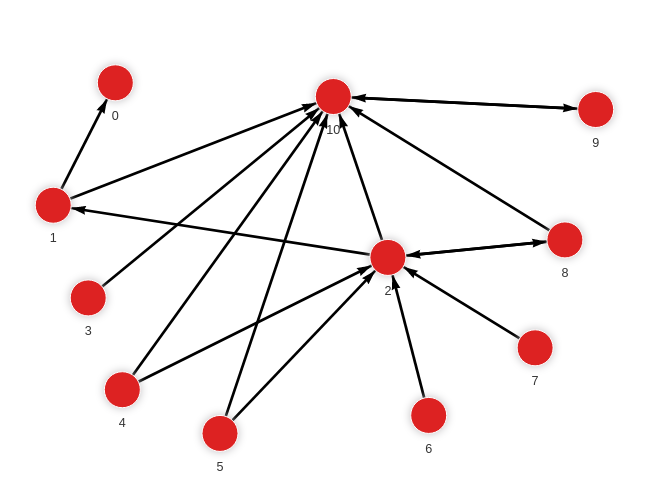katz_centrality_online
Because of its simplicity, Katz Centrality has become one of the most established centrality measurements. The definition of Katz centrality is that it presents the amount of influence by summing all walks starting from the node of interest and weighting walks by some attenuation factor smaller than 1.
Just as the other centrality measures got their dynamic algorithm implementations, so did Katz Centrality. The implementation results in a reduction of computations needed to update already calculated results. The algorithm offers substantially large speedups compared to static algorithm runs.
The algorithm is based on the work of Alexander van der Grinten et. al. called Scalable Katz Ranking Computation in Large Static and Dynamic Graphs1. The author proposes an estimation method that computes Katz's centrality by iteratively improving upper and lower bounds on the centrality scores. The computed scores may differ from the real values, but the algorithm has the guarantee of preserving the rankings.
1 Scalable Katz Ranking Computation in Large Static and Dynamic Graphs, Alexander van der Grinten et. al.
Usage
Online Katz centrality should be used in a specific way. To set the parameters,
the user should call a set() procedure. This function also sets the context of
a streaming algorithm. get() function only returns the resulting values stored
in a cache. Therefore, if you try to get values before first calling set(),
the run will fail with a proper message.
To make the incremental flow, you should set the proper trigger. For that, we'll
use the update() function:
CREATE TRIGGER katz_trigger
(BEFORE | AFTER) COMMIT
EXECUTE CALL katz_centrality_online.update(createdVertices, createdEdges, deletedVertices, deletedEdges) YIELD *
SET node.rank = rank;
Finally, the reset() function resets the context and enables the user to start
new runs.
| Trait | Value |
|---|---|
| Module type | algorithm |
| Implementation | C++ |
| Graph direction | directed |
| Edge weights | unweighted |
| Parallelism | sequential |
Procedures
If you want to execute this algorithm on graph projections, subgraphs or portions of the graph, be sure to check out the guide on How to run a MAGE module on subgraphs.
set(alpha, epsilon)
Input:
alpha: double (default=0.2)➡ Exponential decay factor defining the walk length importance.epsilon: double (default=1e-2)➡ Convergence tolerance. Minimal difference in two adjacent pairs of nodes in the final ranking.
Output:
node➡ Node in the graph, for which Katz Centrality is calculated.rank➡ Normalized ranking of a node. Expresses the centrality value after bound convergence.
Usage:
CALL katz_centrality_online.set(0.2, 0.01)
YIELD node, rank;
get()
* This should be used if the trigger has been set or a set function has been
called before adding changes to the graph.
Output:
node➡ Node in the graph, for which Katz Centrality is calculated.rank➡ Normalized ranking of a node. Expresses the centrality value after bound convergence.
Usage:
CALL katz_centrality_online.get()
YIELD node, rank;
update(created_vertices, created_edges, deleted_vertices, deleted_edges)
Input:
created_vertices➡ Vertices that were created in the last transaction.created_edges➡ Edges created in a period from the last transaction.deleted_vertices➡ Vertices deleted from the last transaction.deleted_edges➡ Edges deleted from the last transaction.
Output:
node➡ Node in the graph, for which Katz Centrality is calculated.rank➡ Normalized ranking of a node. Expresses the centrality value after bound convergence.
Usage:
CREATE TRIGGER katz_trigger
(BEFORE | AFTER) COMMIT
EXECUTE CALL katz_centrality_online.update(createdVertices, createdEdges, deletedVertices, deletedEdges) YIELD *
SET node.rank = rank;
Example
- Step 1: Input graph
- Step 2: Set parameters and trigger
- Step 3: Load commands
- Step 4: Running command
- Step 5: Results

CALL katz_centrality_online.set(0.2) YIELD *;
CREATE TRIGGER katz_trigger
BEFORE COMMIT
EXECUTE CALL katz_centrality_online.update(createdVertices, createdEdges, deletedVertices, deletedEdges) YIELD *
SET node.rank = rank;
MERGE (a:Node {id: 1}) MERGE (b:Node {id: 0}) CREATE (a)-[:RELATION]->(b);
MERGE (a:Node {id: 1}) MERGE (b:Node {id: 10}) CREATE (a)-[:RELATION]->(b);
MERGE (a:Node {id: 2}) MERGE (b:Node {id: 1}) CREATE (a)-[:RELATION]->(b);
MERGE (a:Node {id: 2}) MERGE (b:Node {id: 8}) CREATE (a)-[:RELATION]->(b);
MERGE (a:Node {id: 2}) MERGE (b:Node {id: 10}) CREATE (a)-[:RELATION]->(b);
MERGE (a:Node {id: 3}) MERGE (b:Node {id: 10}) CREATE (a)-[:RELATION]->(b);
MERGE (a:Node {id: 4}) MERGE (b:Node {id: 10}) CREATE (a)-[:RELATION]->(b);
MERGE (a:Node {id: 4}) MERGE (b:Node {id: 2}) CREATE (a)-[:RELATION]->(b);
MERGE (a:Node {id: 5}) MERGE (b:Node {id: 10}) CREATE (a)-[:RELATION]->(b);
MERGE (a:Node {id: 5}) MERGE (b:Node {id: 2}) CREATE (a)-[:RELATION]->(b);
MERGE (a:Node {id: 6}) MERGE (b:Node {id: 2}) CREATE (a)-[:RELATION]->(b);
MERGE (a:Node {id: 7}) MERGE (b:Node {id: 2}) CREATE (a)-[:RELATION]->(b);
MERGE (a:Node {id: 8}) MERGE (b:Node {id: 2}) CREATE (a)-[:RELATION]->(b);
MERGE (a:Node {id: 8}) MERGE (b:Node {id: 10}) CREATE (a)-[:RELATION]->(b);
MERGE (a:Node {id: 9}) MERGE (b:Node {id: 10}) CREATE (a)-[:RELATION]->(b);
MERGE (a:Node {id: 10}) MERGE (b:Node {id: 9}) CREATE (a)-[:RELATION]->(b);
MATCH (node)
RETURN node.id AS node_id, node.rank AS rank;
+---------+---------+
| node_id | rank |
+---------+---------+
| 1 | 0.408 |
| 0 | 0.28 |
| 10 | 1.864 |
| 2 | 1.08 |
| 8 | 0.408 |
| 3 | 0 |
| 4 | 0 |
| 5 | 0 |
| 6 | 0 |
| 7 | 0 |
| 9 | 0.544 |
+---------+---------+
